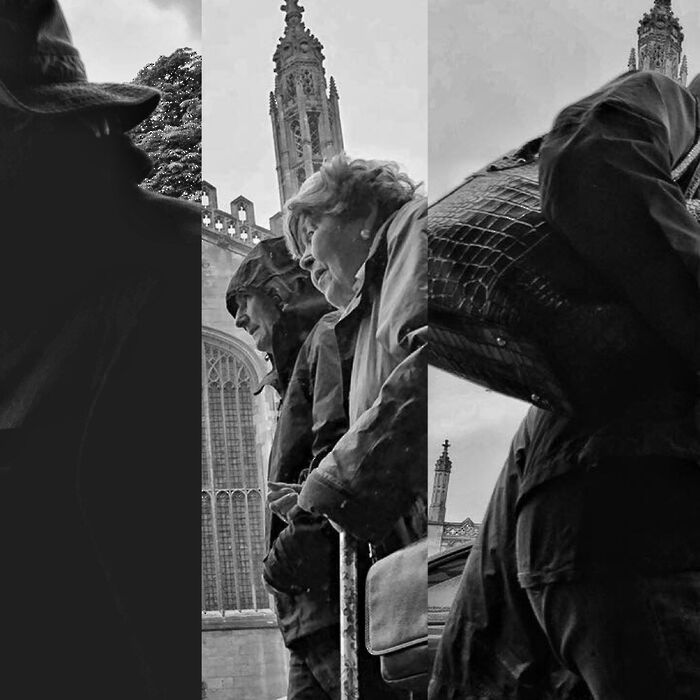Artist clarifies intended meaning of Newnham ‘vulva’ sculpture
Sculptor Cathy de Monchaux said that she had “wanted to make a positive statement about women that wasn’t about sex – it was about women and books”

Newnham College’s new sculpture attracted attention this week following an article in The Observer which described it as a ‘two-storey vulva’. The College, meanwhile, has repeatedly asserted that the sculpture represents ‘a tower of books’.
Artist Cathy de Monchaux spoke to Varsity about the inspiration for her sculpture ‘Beyond Thinking’ as the final piece was fitted on Wednesday. The sculpture, which sits beside the entrance to Newnham Porters Lodge in the new Dorothy Garrod building, will be officially unveiled this Friday.
Although its meaning has been widely debated, De Monchaux claims that The Observer article was a misrepresentation of the interview, claiming that she would “certainly not” use their description of her work as a ‘vulva’ “because this is a sculpture of an open book”.
While she noted that some of her previous work does indeed deliberately contain sexual connotations, she insists that this was not the intention of her piece at Newnham.
She notes that, when designing ‘Beyond Thinking’, she was “very conscious” that Newnham is “a women’s college with cultures from all over the world”. She was also “very conscious” from the outset that the sculpture would be on a public street, and says she “wanted to make a positive statement about women that wasn’t about sex – it was about women and books.”
A University spokesperson claimed that The Observer journalist who reported on the sculpture, Vanessa Thorpe “chose to write something totally misrepresentative and inaccurate that was just her personal opinion”.
Speaking to Varsity, Thorpe argued that de Monchaux did not correct her when she raised the theme of the depiction of female anatomy in her questions to the artist on the Newnham piece.
“[It reflects] that point in academic or creative thinking when... suddenly everything unexpectedly comes together”
Thorpe claimed, “I used the word vagina several times in my questions and at no point did she say “No, it’s not that.”
Thorpe insisted that her report was not misrepresentative: “It’s not my personal opinion because it was the opinion of everyone in the newsroom”. She added that “any news story is a reporter’s interpretation of the facts, gathered and checked over [in] as much time as they have”.
Dame Professor Mary Beard, a fellow of Newnham College, wrote in The Times Literary Supplement on Wednesday about what she interpreted as a dual meaning of the artwork, writing that the sculpture invites the viewer “to think harder about what the relationship is between writing and scholarship on the one hand and female sexuality on the other.”
She argued that this reflexivity makes it “a profoundly academic piece” which is “hugely appropriate for a place of learning”.
‘Beyond Thinking’ began from De Monchaux’s passion for Virginia Woolf’s essay A Room of One’s Own, which itself developed from two lectures Woolf delivered in Cambridge, at Newnham and Girton. The essay includes discussion of the early days of Newnham College, intertwined with reflections on female freedom in education and writing in the context of wider social and economic freedoms for women.
After being commissioned based on her enthusiasm for the essay by Woolf, De Monchaux explains that it took time to determine how to include the multiple aspects of the final design. De Monchaux knew from the start that she wished to include female figures to contrast with the numerous portrayals of men in Cambridge’s art and monuments. In April this year, a statue commemorating Newnham College co-founder Millicent Fawcett was unveiled in London’s Parliament Square.
The other elements of de Monchaux’s sculpture developed over the course of three years.The sculpture’s design had to balance site constraints, as the sculpture was required to be on the Sidgwick Avenue side of the college building, where there was limited space.
Following her desire for the sculpture to represent women, Cambridge’s plant vines came as the second inspiration for de Monchaux’s piece. After her explorations around Cambridge colleges she “really liked how the vines were so abundant, particularly around Cambridge’s older colleges”. The result was a tower of 21 open books, fitted into a niche in the brickwork.
Each book features one of four different female figures embedded into the books’ spines by twisting vines, with the intention of creating a piece which is subtle from a distance but provides engaging layers close-up.
The name, ‘Beyond Thinking’ was chosen to reflect “that point in academic or creative thinking when you just can’t think anymore but suddenly everything unexpectedly comes together”.
 News / SU reluctantly registers controversial women’s soc18 December 2025
News / SU reluctantly registers controversial women’s soc18 December 2025 Features / Should I stay or should I go? Cambridge students and alumni reflect on how their memories stay with them15 December 2025
Features / Should I stay or should I go? Cambridge students and alumni reflect on how their memories stay with them15 December 2025 News / Dons warn PM about Vet School closure16 December 2025
News / Dons warn PM about Vet School closure16 December 2025 News / Cambridge study finds students learn better with notes than AI13 December 2025
News / Cambridge study finds students learn better with notes than AI13 December 2025 News / CUP announces funding scheme for under-represented academics19 December 2025
News / CUP announces funding scheme for under-represented academics19 December 2025










